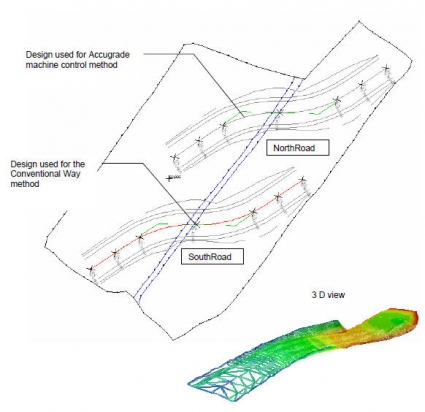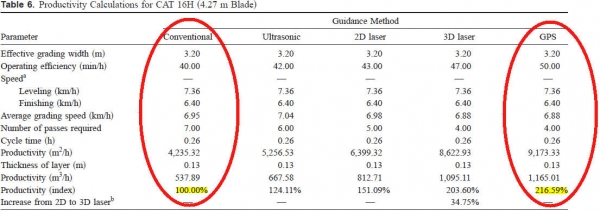Machine Guided Productivity
Referencing three separate reports that directly compare traditional and machine guided construction methods this article highlights the 100+% productivity gains achieved by utilising machine control technologies.
Published: 20th June 2012
Author: MachineGuidance.com.au

Introduction
No two construction projects are the same and so comparing timings of machine-control sites and traditionally-surveyed sites is a considerable challenge. The most accurate way of comparing timings of the two methods would be to complete two exact projects with each of the two methods. Obviously the economics of this make it impossible to accomplish on a large-scale project.
However, two productivity studies have been completed comparing traditional survey methods and machine control guidance on relatively small-scale test sites. The first Productivity Report called "Road Construction Production Study" was conducted in 2006 by the Caterpillar Demonstration & Learning Center in Spain. This report measures the productivity increase using AccuGrade Systems (Caterpillar-branded Trimble Systems) on a simple 80 meter road design including cuts and fills, curves, elevation changes and super elevations.
The second Productivity Report called "GPS Machine Guidance in Construction Equipment" was conducted in 2008 by the Technical University of Reykjavik in Iceland. This report compares the excavation of a simple trench using a 330D excavator both in the conventional way and by way of Trimble GPS guidance.
Results and analysis discovered in these reports, particularly the road construction study, can be applied to other construction projects to estimate a time saving by the use of machine control technologies.

Image - CAT roads

Image - Exc trenches

Survey Productivity
The Caterpillar road productivity comparison demonstrates a fairly simple yet typical section of roadway construction. Looking purely at the survey times accounted for in this study shows a 95% time saving by using machine control methods over traditional survey setout techniques.

Saving in survey time (95%) using machine control methods

Survey Productivity (3)
Similarly, the Reykjavik trench excavation study demonstrates a fairly normal and relatively simple construction activity. Looking again purely at survey times accounted for in the Productivity Report, a saving of 97.7% of survey time is achieved by using machine control guidance over traditional setout methods.

Saving in survey time (97.65%) using machine control methods

Survey Productivity (5)
Therefore, we can extrapolate that road construction projects can achieved at least 95% productivity increase in survey support time by utilising machine control technologies. Note that these time savings do not include survey for structures (for which no machine control is used) nor does it include savings for client-required Quality Assurance checks or the setout of road features that occur after machine control has left (eg line marking, road furniture, etc).

Field Productivity
Not only do machine control technologies represent savings for surveyors, but the productivity studies confirmed significant savings for field operations. The Caterpillar road study report demonstrates productivity gains in terms of percentage of time saved by using machine control guidance methods.

Productivity gains by machine and process using machine control methods

Field Productivity (3)
Note that while the productivity gains don't appear to be as great for the bulk earthworks stage of the study, the excellent performance on the grading stages are largely thanks to the bulk levels being closer with the machine control method, making final grading easier. Similarly, while the 330D excavator does not appear to be significantly faster, the accuracy of the machine control method allowed for more efficient cut-to-fill operations and faster, easier trimming.
Accuracy gains achieved by using machine control technologies also help increase productivity by reducing (if not eliminating) the need for re-work. The accuracy achieved by machine control methods in the Caterpillar road study report was vastly improved over traditional survey methods.

Accuracy comparisons between traditional and machine control methods

Field Productivity (5)
Similarly, the accuracy achieved by machine guidance in the Reykjavik trench excavation study helped achieve a 13.65% saving in material removal and a 59.4% saving in the amount of sand back-filled under the pipes.

Significantly less material removed from the trench excavated using machine control methods

Significantly less material used to back-fill the trench excavated using machine control methods

Field Productivity (8)
In 2002 the Journal of Construction Engineering and Management also published a study that attempted to compare the productivity of conventional survey techniques and machine control methods. Included in this study was a productivity calculation for conventional versus GPS-guided grading - specifically a CAT 140H grader and CAT 16H grader. The results of these calculations demonstrate machine control productivity increases of 101% for the 140H and 116% for the 16H.

CAT 140H Productivity Calculations

CAT 16H Productivity Calculations

Field Productivity (11)
Demonstrations such as these conclusively determine that the utilisation of machine control technologies can and has helped achieve significant field operation time savings. The total earthwork field productivity increase can be estimated at in excess of 100% (i.e. at least twice as fast).

Overall Project Time Savings
The Caterpillar Road Construction Productivity Report demonstrated a 101% productivity gain using machine control with this method taking a total of one and a half days as opposed to three and a half days for the traditional surveyed project. This saving was based on one subgrade layer and one base course layer - even more time savings could be expected for road construction of more layers such as the our case study project which included two grader-placed base course layers.
A summary of the overall activities and timings for the construction of this test road are tabled below.

Timings by construction activity based on 80m road construction (interpreted from CAT Road Study)

Overall Project Time Savings (3)
Similarly, the University of Reykjavik study demonstrated a saving in total project time of 33.5% for the excavation of a relatively simple trench. Note that as this study only compared the excavation of a trench, it effectively measured the time difference for one single operation rather than multiple layers. Also note that when comparing all the work efforts between the two methods a total work effort saving of 57.4% was calculated.

Timings by construction activity based on trench excavation study (interpreted from Reykjavik trench excavation study)

Comparison of total work effort based on Reykjavik trench excavation study

Conclusion
From these direct productivity comparison reports, we can certainly determine that using machine control technologies over traditional construction methods results in a significant productivity gain in overall project construction time.
The results extrapolated from the productivity reports suggest an overall project time saving on the roadway construction of 100+% has been achieved by using machine control technologies.
Note that these studies involve relatively basic alignments. Real life construction projects not only involved the construction of multi-layer roadways, but also involved temporary alignments crossing permanent works. Using a traditional survey method, it is usually only possible to setout and build one alignment at a time. However, using machine control the operators are able to simply change the design displayed on their screen to build multiple alignments together. Thus the time saved would increase even more dramatically on complex road construction projects.

References
- Caterpillar MALAGA Demonstration & Learning Center 2006, "Road Construction Production Study", http://www.trimble-productivity.com/media/pdf/ProductivityReportCATRoadConstruction2006.pdf
- Adalsteinsson, D 2008, "GPS Machine Guidance in Construction Equipment", http://www.trimble-productivity.com/media/pdf/ProductivityReportGPForExcavators2008.pdf
- Jonasson, S, Dunston, P, Ahmed, K & Hamilton, J 2002, "Factors in Productivity and Unit Cost for Advanced Machine Guidance", Journal of Construction Engineering and Management, Vol. 128, No. 5, pp 367-374

Return to Articles Menu


